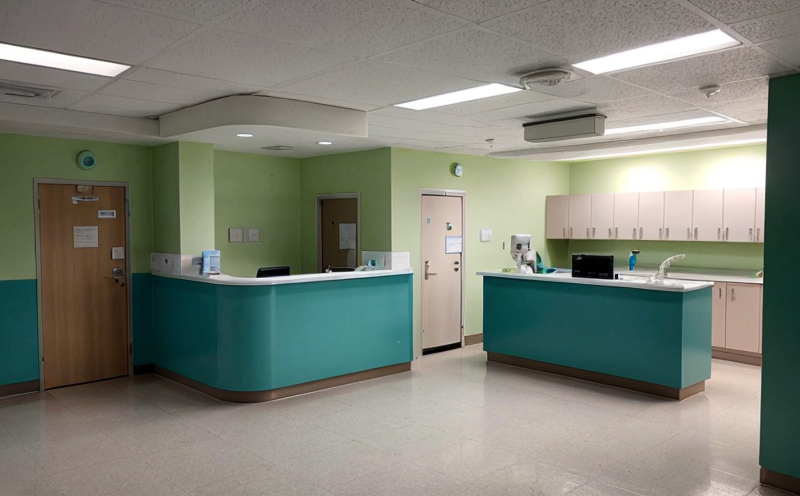EN 16616 Disinfectant Testing in Hospital Laundry Processes
The European Standard EN 16616 sets out requirements and test methods for the microbiological effectiveness of disinfectants used in hospital laundry processes. This standard is crucial for ensuring that the disinfection procedures meet stringent hygiene standards, which are vital to prevent the spread of infections within healthcare facilities.
The scope of EN 16616 includes both liquid and powder disinfectants intended for use on textiles and other items in hospital laundry processes. The standard ensures that these disinfectants can effectively eliminate pathogens such as bacteria, viruses, fungi, and spores without compromising the integrity of the textile or causing harm to users.
The testing procedures outlined in this standard are designed to simulate real-world conditions encountered in hospital laundry facilities. This includes factors like water hardness, detergent presence, and temperature variations that can influence disinfection efficacy. The tests also consider the impact of different washing cycles, including pre-wash steps, main wash phases, and final rinse processes.
Key aspects of EN 16616 include:
- Microbial Load Reduction: The standard specifies quantitative reductions in microbial load that disinfectants must achieve. This ensures that the disinfectant is capable of effectively reducing harmful microorganisms.
- Water Hardness Tolerance: Tests are conducted under conditions of varying water hardness to ensure that the disinfectant remains effective across different geographical regions and water supplies.
- Detergent Interference: The presence of detergent in the wash cycle is considered, as it can affect the performance of disinfectants. Tests must account for this interference to provide accurate results.
The testing process involves inoculating textiles with known microbial cultures and then exposing them to the disinfectant under conditions that mimic actual laundry processes. After treatment, samples are analyzed for residual microorganisms to determine if they meet the specified reduction criteria.
For quality managers and compliance officers within hospital and healthcare settings, this standard is essential in ensuring that the chosen disinfectants not only comply with regulatory requirements but also perform effectively under real-world conditions. R&D engineers can leverage EN 16616 to innovate new formulations that meet or exceed these stringent standards.
For procurement teams, selecting products that adhere to this standard ensures reliable and effective disinfection processes, contributing significantly to patient safety and infection control within healthcare environments.
Applied Standards
The primary applied standards for EN 16616 Disinfectant Testing in Hospital Laundry Processes are:
- EN 16616: Microbiological effectiveness of disinfectants used in hospital laundry processes — Requirements and test methods
These standards provide the framework for testing procedures that ensure disinfectants are effective against a wide range of pathogens. Compliance with these standards ensures consistent quality and reliability across different products and brands.
Benefits
The implementation of EN 16616 brings several significant benefits to healthcare facilities:
- Enhanced Patient Safety: By ensuring that disinfectants are effective against pathogens, the standard helps prevent hospital-acquired infections (HAIs), which are a major concern in healthcare settings.
- Regulatory Compliance: Adhering to this standard ensures that facilities meet regulatory requirements and can avoid potential legal issues or sanctions.
- Improved Laundry Efficiency: The standard helps optimize the laundry process by selecting disinfectants that are effective under various conditions, thus improving overall operational efficiency.
- Reduced Risk of Infection Transmission: Effective disinfection reduces the risk of transmission of infectious agents between patients and staff, thereby enhancing the safety of healthcare environments.
These benefits contribute to a safer and more effective healthcare environment, which is critical for patient care and overall facility operation.
Quality and Reliability Assurance
- Consistent Quality Control: Regular testing against EN 16616 ensures that disinfectants maintain consistent quality across batches and production runs.
- Improved Product Performance: By adhering to these standards, manufacturers can improve the performance of their products, ensuring they meet or exceed market expectations.
- Increased Confidence in Purchasing Decisions: Healthcare facilities that select disinfectants compliant with EN 16616 can have greater confidence in their purchasing decisions, knowing they are choosing effective and reliable products.
Quality assurance programs based on this standard help maintain high standards of hygiene and infection control within healthcare settings.





